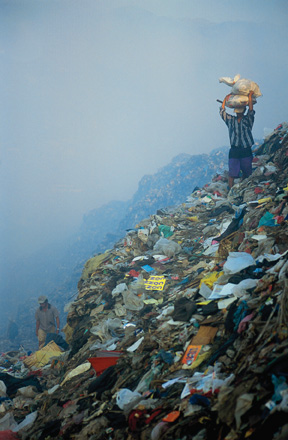[Summer 2009]
Galerie d’art du Centre Culturel
Université de Sherbrooke
January 12 to February 22, 2009
Previously exhibited at Cirque du Soleil’s TOHU Espace SSQ, Paul-Antoine Pichard’s photographs of people who live amid trash, in the scarred landscapes that they are a part of, reveal scarred, aged, disfigured victims of the conditions imposed on them by extreme poverty, bad planning, and general neglect. For over ten years, French photographer Pichard has documented the other side of the dreamscape of hyper-consumption in the shifting sands of Third World’s emerging economies. What these photo documents reveal is there for all to see: an underclass that is the result of the failure of the International Monetary Fund and World Bank’s reforms in these societies. The United Nation’s Charter of Rights designates food, water, and proper shelter or habitat as basic human rights. The so-called scavengers in Pichard’s photographs have none of this.
While Pichard’s approach is largely documentary, the subjects of the photographs in Trash Mines are more deplorable and less imaginable than the homeless tramps about whom George Orwell wrote in Down and Out in Paris and London (1933). With an approach not so different from Orwell’s, Pichard works on site, engages with people, and encounters their lives as they are lived. In so doing he has captured an the entire Third World subculture whose state of being is precarious, perilous, prone to illness and disease. Pichard presented his photographs to Gotskin Sipahioglu, a mythical figure in the photography world and founder of the SIPA PRESS agency. Sipahioglu proposed that Pichard go to Ketama, Morocco, to investigate the hashish trade; he did so, living there for a year documenting it all. Indeed, the aesthetic that he has adopted is near anthropological: a live-as-you-work, hands-on approach that involves social, cultural, and economic interaction with and total commitment to the subject.
In these documents, we see people who live in makeshift villages, families who farm the trash and live their entire lives breathing in the toxic fumes, smoke, and methane that are part of these environments. These people recycle metal, find basic food, and try to sell some of what they find. This daily heaven-and-hell existence is the norm for tens of thousands. The colours in these literal and visual landscapes of trash are vivid. Amid the mountainous volumes of trash we see dogs and children, figures in a fog of pollution, whether it be in Mexico, Thailand, India, Egypt, Senegal, Cambodia, or Madagascar.
The entire lives of young children, babies, and women revolve around and are based in trash. In Dakar – Senegal (2001), we see a child pulling a bag of trash that is larger than him. The Manila dump in Smoky Mountain is a sprawling topography of detritus that extends for miles. Hundreds of the thousands who dig through, collect, and sort garbage there were killed when the trash shifted due to extensive rains in July 2000. Another colour photograph, Bombay, India (2003), shows a blue-turbaned woman sitting on trash and nursing her child. One Trash Mines caption tells us that babies left alone while their parents are away have their fingers and toes eaten by rats. A not-quite-dead donkey is dumped in an Egyptian landfill and covered over by successive layers of trash. The endless buzz of millions of flies and crawling maggots are part of the wasteland-scape reality, and the potential for the spread of disease is very great. These photos awaken us to the survival stories of Third World peoples.
Nowhere is the inequity between rich and poor more evident than in the trash heaps of the Third World. In the West, the metabolism of capitalism produces an incredible volume of waste; the same is true for emerging economies in the Third World. As product quality is sacrificed in the name of cheap pricing, new products have a very short lifespan before heading for the landfill. And with planned obsolescence, a practice that Vance Packard denounced in The Hidden Persuaders as early as 1957, filling the void with consumer items seems a shallow game that ultimately leads to computer parts, printers, and furniture in our streets instead of at repair shops and recycling depots. Product-designed obsolescence speeds up the cycle, so the time span from storefront to junk may be less than a year.
A neglect for basic human rights leads to the environments and situations that the people in Pichard’s photographs inhabit. These works are completely at odds with the nuanced, distant, cold, and antiseptic industrial-scaled approach of much contemporary photography that deals with these issues. Pichard’s photographs reflect an ongoing social commitment and conscience. These photo-scapes, for all the trash and pollution, are quintessentially human-scapes that engage this global situation and the issues that they reflect with compassion and a sense of urgency.
John Grande has authored Balance: Art and Nature (Black Rose Books, 1994), Art Nature Dialogues: Interviews with Environmental Artists (www.sunypress.edu), and Dialogues in Diversity: Art from Marginal to Mainstream (www.paripublishing.com). He is curating Earth Art at the Royal Botanical Gardens (www.rbg.ca) this summer (www.grandescritique.com).


